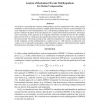Free Online Productivity Tools
i2Speak
i2Symbol
i2OCR
iTex2Img
iWeb2Print
iWeb2Shot
i2Type
iPdf2Split
iPdf2Merge
i2Bopomofo
i2Arabic
i2Style
i2Image
i2PDF
iLatex2Rtf
Sci2ools
97
Voted
DCC
2006
IEEE
2006
IEEE
Analysis of Redundant-Wavelet Multihypothesis for Motion Compensation
An analysis is presented that examines multihypothesis motion-compensated video coding using a redundant wavelet transform to produce multiple predictions that are diverse in transform phase. In such redundant-wavelet multihypothesis, the corresponding multiple-phase inverse transform implicitly combines the phase-diverse predictions into a single spatial-domain prediction. The performance advantage of this approach is investigated analytically, invoking the fact that the multiplephase inverse involves a projection that significantly reduces the power of the noise not captured by the motion model. The analysis predicts that, under the assumption of a simple translational motion model, redundant-wavelet multihypothesis is capable of up to a 7-dB reduction in prediction-error variance over an equivalent single-phase, single-hypothesis approach. Experimental results support the performance advantage for real motion-compensation residuals.
Computer Graphics | DCC 2006 | Multiple-phase Inverse Transform | Redundant Wavelet Transform | Translational Motion Model |
Related Content
| Added | 25 Dec 2009 |
| Updated | 25 Dec 2009 |
| Type | Conference |
| Year | 2006 |
| Where | DCC |
| Authors | James E. Fowler |
Comments (0)

